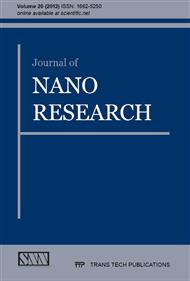[1]
J. Alvar, I.D. Vélez, C. Bern, M. Herrero, P. Desjeux, J. Cano, J. Jannin, M. Boer, The WHO Leishmaniasis Control Team, Leishmaniasis. Worldwide and global estimates of its incidence, Plos One. 7 (2012) e35671.
DOI: 10.1371/journal.pone.0035671
Google Scholar
[2]
T. Garnier, S.L. Croft, Topical treatment for cutaneous leishmaniasis, Curr Opin Investig Drugs. 3 (2002) 538-544.
Google Scholar
[3]
A.M. Alkhawajah, E. Larbi, Y. al-Gindan, A. Abahussein, S. Jain, Treatment of cutaneous leishmaniasis with antimony: intramuscular versus intralesional administration, Ann Trop Med Parasitol. 91 (1997) 899-905.
DOI: 10.1080/00034983.1997.11813217
Google Scholar
[4]
I. Esfandiarpour, S. Farajzadeh, Z. Rahnama, E. A. Fathabadi, A. Heshmatkhah, Adverse effects of intralesional meglumine antimoniate and its influence on clinical laboratory parameters in the treatment of cutaneous leishmaniasis, International Journal of Dermatology. 10 (2012).
DOI: 10.1111/j.1365-4632.2012.05460.x
Google Scholar
[5]
M. Navarro, E. J. Cisneros-Fajardo and E. Marchan, New silver polypyridyl complexes: synthesis, characterization, and biological activity on Leishmania Mexicana, Arzn. Forsch. 56 (2006) 600-604.
DOI: 10.1055/s-0031-1296758
Google Scholar
[6]
A.B. Seabra, and N. Durán, Nitric oxide-releasing vehicles for biomedical applications, Journal of Materials Chemistry. 20 (2010) 1624-1637.
DOI: 10.1039/b912493b
Google Scholar
[7]
E.C. Torres-Santos, M.I. Sampaio-Santos, F.S. Buckner, K. Yokoyama, M. Gelb, J. A. Urbina, B. Rossi-Bergmann, Altered sterol profile induced in Leishmania amazonensis by a natural dihydroxymethoxylated chalcone, J. Antimicrob. Chemother. 63 (2009).
DOI: 10.1093/jac/dkn546
Google Scholar
[8]
I. Arevalo, B. Ward, R. Miller, T.C. Meng, E. Najar, E. Alvarez, G. Matlashewski, A. Llanos-Cuentas, Successful treatment of drug-resistant cutaneous leishmaniasis in humans by use of imiquimod, an immunomodulator, Clinical Infectious Diseases. 33 (2001).
DOI: 10.1086/324161
Google Scholar
[9]
A.M. Allahverdiyev, S.A. Emrah, M. Bagirova, C.B. Ustundag, C. Kaya, F. Kaya, and M. Rafailovich, Antileishmanial effect of silver nanoparticles and their enhanced antiparasitic activity under ultraviolet light, Int J Nanomedicine. 6 (2011).
DOI: 10.2147/ijn.s23883
Google Scholar
[10]
P.D. Marcato, R. De Conti, B. Rossi-Bergmann and N. Durán, Silver nanoparticles/clindamycin: antileishmanial activity VII Ann. Meeting of SBPMat, (2008) September 28-October 2, Guarujá-SP, Brasil.
Google Scholar
[11]
P. Mohanpuria, P.N.K. Rana, and S.K. Yadav, Biosynthesis of nanoparticles: technological concepts and future applications J. Nanopart. Res. 10 (2008) 507-517.
DOI: 10.1007/s11051-007-9275-x
Google Scholar
[12]
V.K. Sharma, R.A. Yngard, and Y. Lin, Silver nanoparticles: Green synthesis and their antimicrobial activities Advan. Colloid Interf. Sci. 145 (2009) 83-96.
DOI: 10.1016/j.cis.2008.09.002
Google Scholar
[13]
V. Deepak, P.S. Umamaheshwaran, K. Guhan, R.A. Nanthini, B. Krithiga, N.M.H. Jaithoon, S. Gurunathan, Synthesis of gold and silver nanoparticles using purified. Collids and Surfaces B-Biointerfaces, 86 (2011) 353-358.
DOI: 10.1016/j.colsurfb.2011.04.019
Google Scholar
[14]
N. Durán, P.D. Marcato, M. Durán, A. Yadav, A. Gade, M. Rai, Mechanistic aspects in the biogenic synthesis of extracellular metal nanoparticles by peptides, bacteria, fungi, and plants. Applied Microbiology and Biotechnology. 90 (2011) 1609-1624.
DOI: 10.1007/s00253-011-3249-8
Google Scholar
[15]
G.P. Pei, L.S.F.Y. Yau, Potential of plant as a biological factory to synthesize gold and silver nanoparticles and their applications, Reviws in Environmental Science and Bio-technology. 11 (2012) 169-206.
DOI: 10.1007/s11157-012-9278-7
Google Scholar
[16]
T.N.V.K.V. Prasad, V.S.R. Kambala, R. Naidu, A Critical Review on Biogenic Silver Nanoparticles and their Antimicrobial Activity. Current Nanoscience. 4 (2011) 531-544.
DOI: 10.2174/157341311796196736
Google Scholar
[17]
N. Durán, P.D. Marcato, O.L. Alves, H.I.H. De Souza, and E. Esposito, Mechanistic aspects of biosyntheis of silver nanoparticles by several Fusarium oxysporum strains. J. Nanobiotechnol. 3 (2005) 1-7.
DOI: 10.1186/1477-3155-3-8
Google Scholar
[18]
N. Durán, P.D. Marcato, H.I.H. De Souza, O.L. Alves, and E. Esposito, Antibacterial effect of silver nanoparticles produced by fungal process on textile fabrics and their effluent treatment. J. Biomed. Nanotechnol. 3 (2007) 203-208.
DOI: 10.1166/jbn.2007.022
Google Scholar
[19]
M. Mohebali, M.M. Rezayat, K. Gilani, S. Sarkar, B. Akhoundi, J. Esmaeili, T. Satvat, S. Elikaee, S. Charehdar, H. Hooshyar, Nanosilver in the treatment of localized cutaneous leishmaniasis caused by Leishmania major (MRHO/IR/75/ER): an in vitro and in vivo study. DARU. 17 (2009).
DOI: 10.1007/s00436-019-06382-y
Google Scholar
[20]
A.M. Allahverdiyev, E.S. Abamor, M. Bagirova, C.B. Ustundag, C. Kaya, F. Kaya, M. Rafailovich, Antileishmanial effect of silver nanoparticles and their enhanced antiparasitic activity under ultraviolet light. International Journal of Nanomedicine. 6 (2011).
DOI: 10.2147/ijn.s23883
Google Scholar
[21]
B. Rossi-Bergmann, C.A.B. Falcão, A. Lenglet, C.R. Bezerra-Santos, D. Costa-Pinto and Y.M. Traub-Czeko, A simple fluorimetric method for assessing drug and vaccine efficacy in cutaneous leishmaniasis using Leishmania amazonensis expressing green fluorescence protenin Mem. I. Oswaldo Cruz (Suppl. II), 94 (1999).
Google Scholar
[22]
F.C. Silva Filho, E.M. Saraiva, M.A. Santos, W. de Souza, The surface free energy of Leishmania mexicana amazonensis. Cell Biophys. 2 (1990) 137-51.
Google Scholar
[23]
S.L. Croft, and G.H. Coombs, Leishmaniasis - current chemotherapy and recent advances in the search for novel drugs. Trends in Parasitology. 19 (2003) 502-508.
DOI: 10.1016/j.pt.2003.09.008
Google Scholar
[24]
F.J. Abajo and A.J. Carcas Amphotericin-B Hepatotoxicity. British Medical Jounal. 293 (1986) 1243-1243.
DOI: 10.1136/bmj.293.6556.1243-b
Google Scholar
[25]
I. Karimzadeh, S. Farsaei, H. Khalili, S. Dashti-Khavidaki, Are salt loading and prolonging infusion period effective in prevention of amphotericin B-induced nephrotoxicity? Expert Opinion on Drug Safety. 11 (2012) 969-983.
DOI: 10.1517/14740338.2012.721775
Google Scholar


